Forecasting the Final Contract Cost on the Basis of the Owner’s Cost Estimation Using an Artificial Neural Network
Abstract
1. Introduction
2. Literature Review
2.1. Factors Affecting the OCE and Bidding Deviation
2.2. Factors Affecting Changes CC and Change Orders
2.3. Former Forecast Cost Construction Models
3. Case Study and Study Hypotheses
- Entering fewer complete drawings in a hotel project is a considerable risk. It is highly recommended to obtain design drawings fully approved by the hotel operator to control the project cost.
- Hotel investors must calculate the opportunity income or benefits before choosing a fixed construction contract.
- In such a hospitality project, more than traditional value engineering analysis is needed. Involved parties should also study the market’s value and competitiveness in addition to defining the project’s quality, function, and cost.
- It is recommended to control the hotel operators’ requests to increase the hotel’s quality. It is crucial that owners or investors study these requests carefully. Usually, the operator needs to maximize the hotel cost during construction to gain more profit after opening the hotel. Any expenses during the hotel operation will be reduced from project income and then minimize the hotel operator’s profit.
- Using the forecasting technique described in this study could help the owner make a more informed decision and manage project risks before accepting any commitments.
4. Methodology
4.1. Step 1: Data Collection
4.2. Step 2: Perform Correlation Tests
4.3. Step 3: Examine the Size and Normality Tests of the Data
4.4. Step 4: Develop an Appropriate Model
4.5. Step 5: Assessment and Evaluation Models
4.6. Step 6: Increase the Model’s Accuracy
5. Results and Discussion
5.1. Results of Correlation, Sample Size, and Normality Tests
5.2. ANN Model
6. Recommendation and Future Study
7. Conclusions
Author Contributions
Funding
Data Availability Statement
Acknowledgments
Conflicts of Interest
References
- Christensen, D.S.; Gordon, J.A. Does a Rubber Baseline Guarantee Cost Overruns on Defense Acquisition Contracts? Proj. Manag. J. 1998, 29, 43–51. [Google Scholar] [CrossRef]
- Thomas, N.; Thomas, A.V. Regression Modelling for Prediction of Construction Cost and Duration. Appl. Mech. Mater. 2016, 857, 195–199. [Google Scholar] [CrossRef]
- Gao, X.; Pishdad-Bozorgi, P. A framework of developing machine learning models for facility life-cycle cost analysis. Build. Res. Inf. 2020, 48, 501–525. [Google Scholar] [CrossRef]
- Ye, D. An Algorithm for Construction Project Cost Forecast Based on Particle Swarm Optimization-Guided BP Neural Network. Sci. Program. 2021, 2021, 4309495. [Google Scholar] [CrossRef]
- Lowe, D.J. Predicting construction cost using multiple regression techniques. J. Constr. Eng. Manag. 2006, 132, 750–758. [Google Scholar] [CrossRef]
- Badawy, M. A hybrid approach for a cost estimate of residential buildings in Egypt at the early stage. Asian J. Civ. Eng. 2020, 21, 763–774. [Google Scholar] [CrossRef]
- Skitmore, R.M.; Ng, S.T. Forecast models for actual construction time and cost. Build. Environ. 2003, 38, 1075–1083. [Google Scholar] [CrossRef]
- Aretoulis, G.N. Neural network models for actual cost prediction in Greek public highway projects. Int. J. Proj. Organ. Manag. 2019, 11, 41. [Google Scholar] [CrossRef]
- Albtoush, F.; Ing, D.S.; Rahman, R.A.; Al-Btoosh, J.A.A. Factors Affecting the Accuracy of Cost Estimate in Construction Projects: A Review. In Proceedings of the National Conference for Postgraduate Research (NCON-PGR 2020), Virtual Mode, 9 December 2020; pp. 1–9. [Google Scholar]
- Saqer, F. Development of Cost Estimation Model for Ministry of Youth and Sports Affairs Construction Projects A Case study from Kingdom of Bahrain. Master’s Thesis, University of Bahrain, Manama, Kingdom of Bahrain, 2020. [Google Scholar]
- Baek, M.; Ashuri, B. Assessing low bid deviation from engineer’s estimate in highway construction projects. In Proceedings of the 55th Associated Schools of Construction Annual International Conference, Denver, CO, USA, 10–13 April 2019; pp. 371–377. [Google Scholar]
- Senouci, A.; Ismail, A.; Eldin, N. Time Delay and Cost Overrun in Qatari Public Construction Projects. Procedia Eng. 2016, 164, 368–375. [Google Scholar] [CrossRef]
- Mahamid, I. Contractors’ perception of risk factors affecting cost overrun in building projects in Palestine. IES J. Part A Civ. Struct. Eng. 2014, 7, 38–50. [Google Scholar] [CrossRef]
- Keane, P.; Sertyesilisik, B.; Ross, A.D. Variations and Change Orders on Construction Projects. J. Leg. Aff. Disput. Resolut. Eng. Constr. 2010, 2, 89–96. [Google Scholar] [CrossRef]
- Khalifa, W.M.A.; Mahamid, I. Causes of Change Orders in Construction Projects. Eng. Technol. Appl. Sci. Res. 2019, 9, 4956–4961. [Google Scholar] [CrossRef]
- Elbeltagi, E.; Elshahat, A.; Dawood, M.; Alaryan, A. Causes and Effects of Change Orders on Construction Projects in Kuwait. Int. J. Eng. Res. Appl. 2014, 4, 1–8. [Google Scholar]
- Alnuaimi, A.S.; Taha, R.A.; Al Mohsin, M.; Al-Harthi, A.S. Causes, Effects, Benefits, and Remedies of Change Orders on Public Construction Projects in Oman. J. Constr. Eng. Manag. 2010, 136, 615–622. [Google Scholar] [CrossRef]
- Desai, J.N.; Pitroda, J.; Bhavasar, J.J. Analysis of Factor Affecting Change Order in Construction Industry Using RII Method. Int. J. Mod. Trends Eng. Res. 2015, 2, 344–347. [Google Scholar]
- Capen, E.C.; Clapp, R.V.; Campbell, W.M. Competitive bidding in high-risk situations. J. Pet. Technol. 1971, 23, 641–653. [Google Scholar] [CrossRef]
- Bromilow, F.J. Measurement and scheduling of construction time and cost performance in the building industry. Chart. Build. 1974, 10, 57–65. [Google Scholar]
- Ngai, S.C.; Drew, D.S.; Lo, H.P.; Skitmore, M. A theoretical framework for determining the minimum number of bidders in construction bidding competitions. Constr. Manag. Econ. 2002, 20, 473–482. [Google Scholar] [CrossRef]
- Carr, P.G. Investigation of bid price competition measured through prebid project estimates, actual bid prices, and number of bidders. J. Constr. Eng. Manag. 2005, 131, 1165–1172. [Google Scholar] [CrossRef]
- Li, S.; Foulger, J.R.; Philips, P.W. Analysis of the impacts of the number of bidders upon bid values: Implications for contractor prequalification and project timing and bundling. Public Work. Manag. Policy 2008, 12, 503–514. [Google Scholar]
- Li, M.; Baek, M.; Ashuri, B. Forecasting Ratio of Low Bid to Owner’s Estimate for Highway Construction. J. Constr. Eng. Manag. 2021, 147, 04020157. [Google Scholar] [CrossRef]
- Li, M.; Zheng, Q.; Ashuri, B. Predicting Ratio of Low Bid to Owner’s Estimate Using Feedforward Neural Networks for Highway Construction. In Proceedings of the Construction Research Congress, Arlington, VA, USA, 9–12 March 2022; pp. 340–350. [Google Scholar]
- Badawy, M.; Alqahtani, F.; Hafez, H. Identifying the risk factors affecting the overall cost risk in residential projects at the early stage. Ain Shams Eng. J. 2022, 13, 101586. [Google Scholar] [CrossRef]
- Ngo, K.A.; Lucko, G.; Ballesteros-Pérez, P. Continuous earned value management with singularity functions for comprehensive project performance tracking and forecasting. Autom. Constr. 2022, 143, 104583. [Google Scholar] [CrossRef]
- Leon, H.; Osman, H.; Georgy, M.; Elsaid, M. System Dynamics Approach for Forecasting Performance of Construction Projects. J. Manag. Eng. 2018, 34. [Google Scholar] [CrossRef]
- Natarajan, A. Reference Class Forecasting and Machine Learning for Improved Offshore Oil and Gas Megaproject Planning: Methods and Application. Proj. Manag. J. 2022, 53, 456–484. [Google Scholar] [CrossRef]
- Espinosa-Garza, G.; Loera-Hernández, I. Proposed model to improve the forecast of the planned value in the estimation of the final cost of the construction projects. Procedia Manuf. 2017, 13, 1011–1018. [Google Scholar] [CrossRef]
- Odeyinka, H.; Lowe, J.; Kaka, A. Regression modelling of risk impacts on construction cost flow forecast. J. Financ. Manag. Prop. Constr. 2012, 17, 203–221. [Google Scholar] [CrossRef]
- Xu, C.; Wang, Y.; Ye, K.; Zhang, S.; Zou, M.; Chen, C. Research on transmission line project cost forecast method based on BP neural network. IOP Conf. Ser. Mater. Sci. Eng. 2019, 688, 055074. [Google Scholar] [CrossRef]
- Ng, S.T.; Cheung, S.O.; Skitmore, M.; Wong, T.C.Y. An integrated regression analysis and time series model for construction tender price index forecasting. Constr. Manag. Econ. 2004, 22, 483–493. [Google Scholar] [CrossRef]
- Kim, B.-C.; Reinschmidt, K.F. Combination of Project Cost Forecasts in Earned Value Management. J. Constr. Eng. Manag. 2011, 137, 958–966. [Google Scholar] [CrossRef]
- Mir, M.; Kabir, H.D.; Nasirzadeh, F.; Khosravi, A. Neural network-based interval forecasting of construction material prices. J. Build. Eng. 2021, 39, 102288. [Google Scholar] [CrossRef]
- Moghayedi, A.; Windapo, A. Predicting the impact size of uncertainty events on construction cost and time of highway projects using ANFIS technique. In Collaboration and Integration in Construction, Engineering, Management and Technology; Springer: Berlin/Heidelberg, Germany, 2021; pp. 203–209. [Google Scholar]
- Shrestha, P.P.; Pradhananga, N. Correlating bid price with the number of bidders and final construction cost of public street projects. Transp. Res. Rec. 2010, 2151, 3–10. [Google Scholar] [CrossRef]
- Loy, J. Neural Network Projects with Python: The Ultimate Guide to Using Python to Explore the True Power of Neural Networks Through Six Projects; Packt Publishing: Birmingham, UK, 2019. [Google Scholar]
- Anysz, H.; Zbiciak, A.; Ibadov, N. The Influence of Input Data Standardization Method on Prediction Accuracy of Artificial Neural Networks. Procedia Eng. 2016, 153, 66–70. [Google Scholar] [CrossRef]
- Pasini, A. Artificial neural networks for small dataset analysis. J. Thorac. Deisease 2015, 7, 953–960. [Google Scholar]
- Zayed, T. Assessment of Productivity for Concrete Bored Pile Construction. Ph.D. Dissertation, Purdue University, West Lafayette, IN, USA, 2001. [Google Scholar]
- Amiri, A.; Mirzakuchaki, S. A digital watermarking method based on NSCT transform and hybrid evolutionary algorithms with neural networks. SN Appl. Sci. 2020, 2, 1669. [Google Scholar] [CrossRef]
- Vinayagam, R.; Dave, N.; Varadavenkatesan, T.; Rajamohan, N.; Sillanpää, M.; Nadda, A.K.; Govarthanan, M.; Selvaraj, R. Artificial neural network and statistical modelling of biosorptive removal of hexavalent chromium using macroalgal spent biomass. Chemosphere 2022, 296, 133965. [Google Scholar] [CrossRef]
- Swanson, D.A. On the Relationship among Values of the Same Summary Measure of Error when It Is Used across Multiple Characteristics at the Same Point in Time: An Examination of MALPE and MAPE1. 2015. Available online: https://escholarship.org/content/qt1f71t3x9/qt1f71t3x9_noSplash_9c507cef1229a954e3e9b7a2ee9ef217.pdf?t=o5wul1 (accessed on 15 March 2023).
- Chicco, D.; Warrens, M.J.; Giuseppe, J. The coefficient of determination R-squared is more informative than SMAPE, MAE, MAPE, MSE and RMSE in regression analysis evaluation. PeerJ Comput. Sci. 2021, 7, e623. [Google Scholar] [CrossRef]
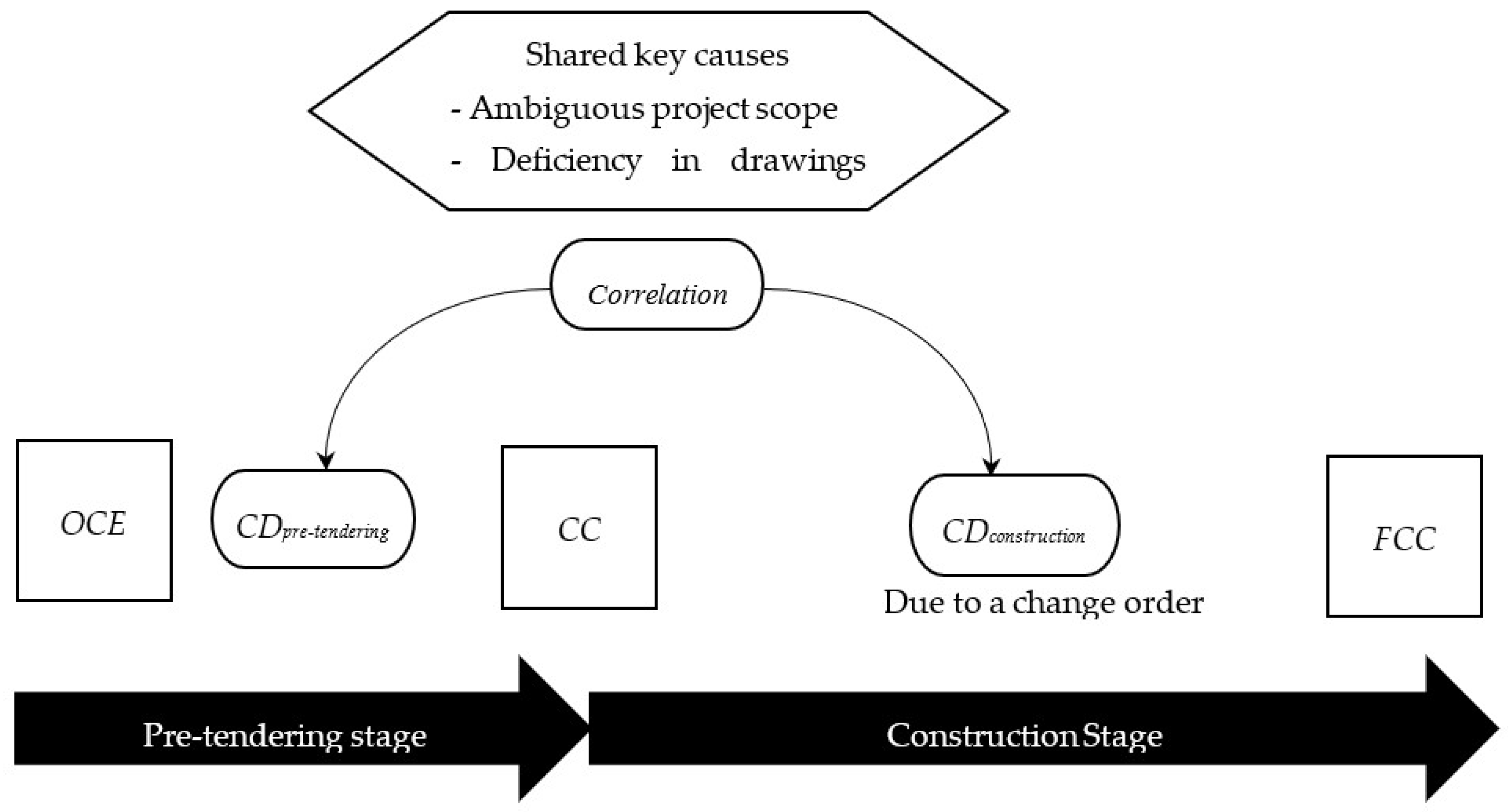
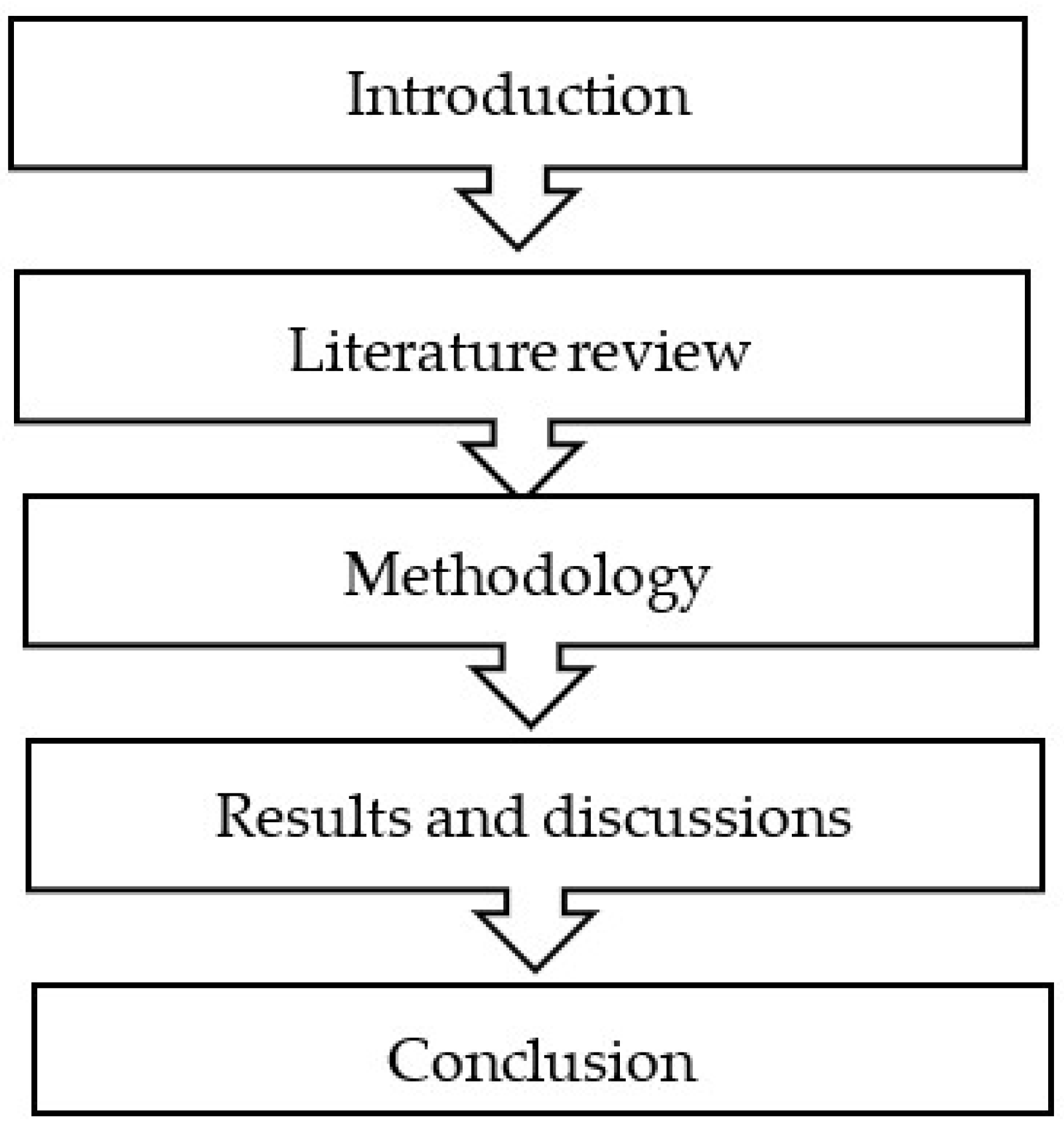
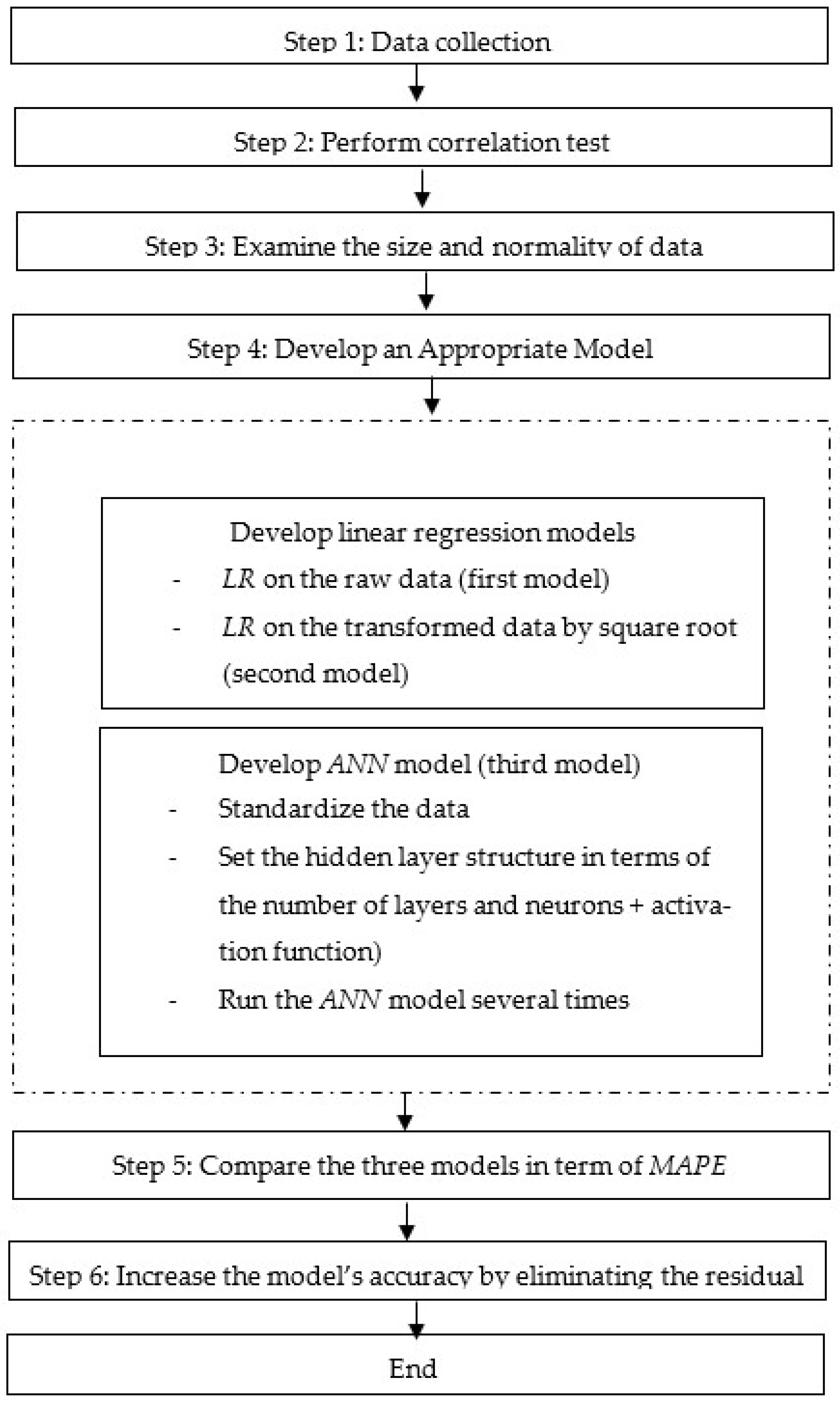

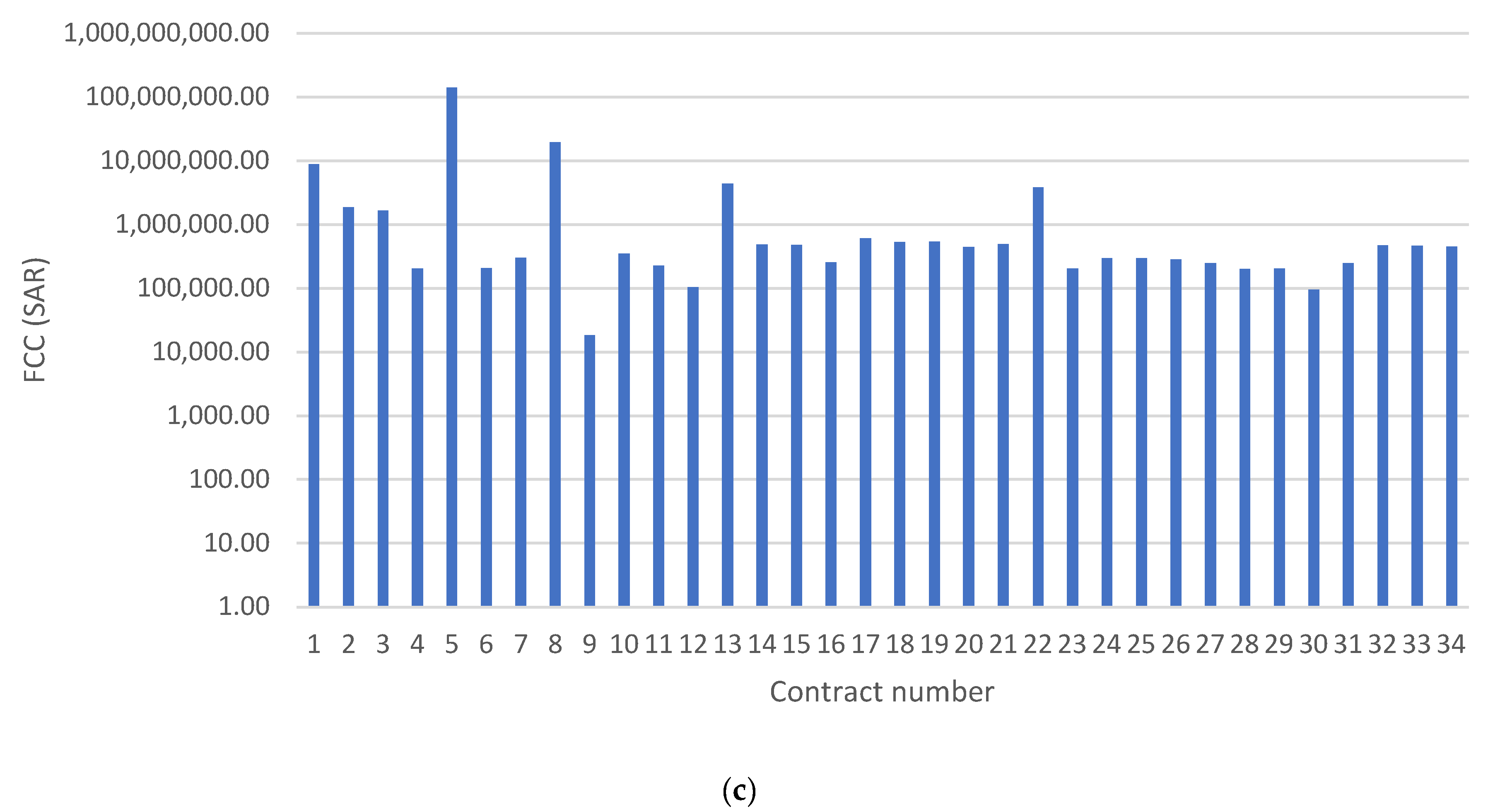

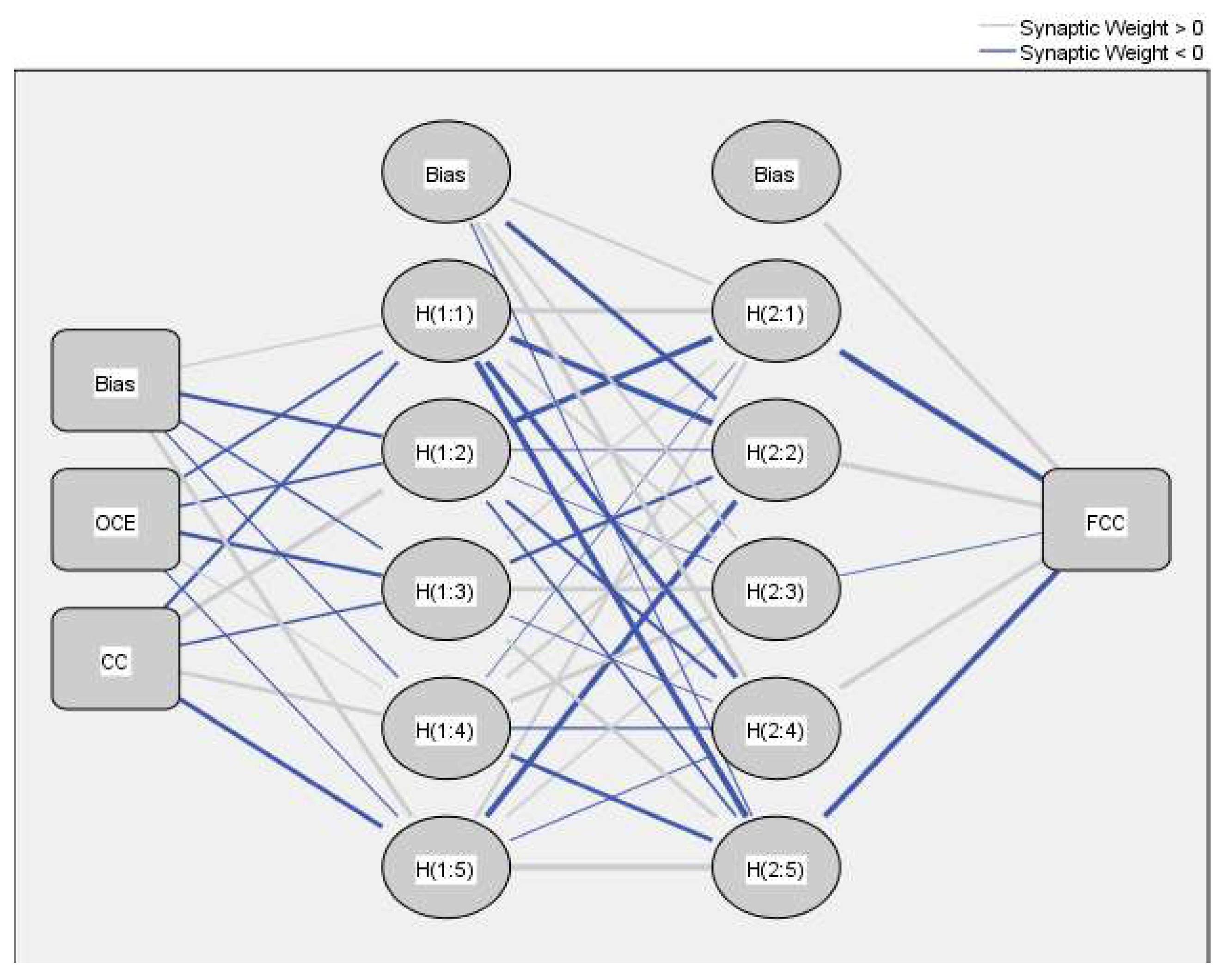
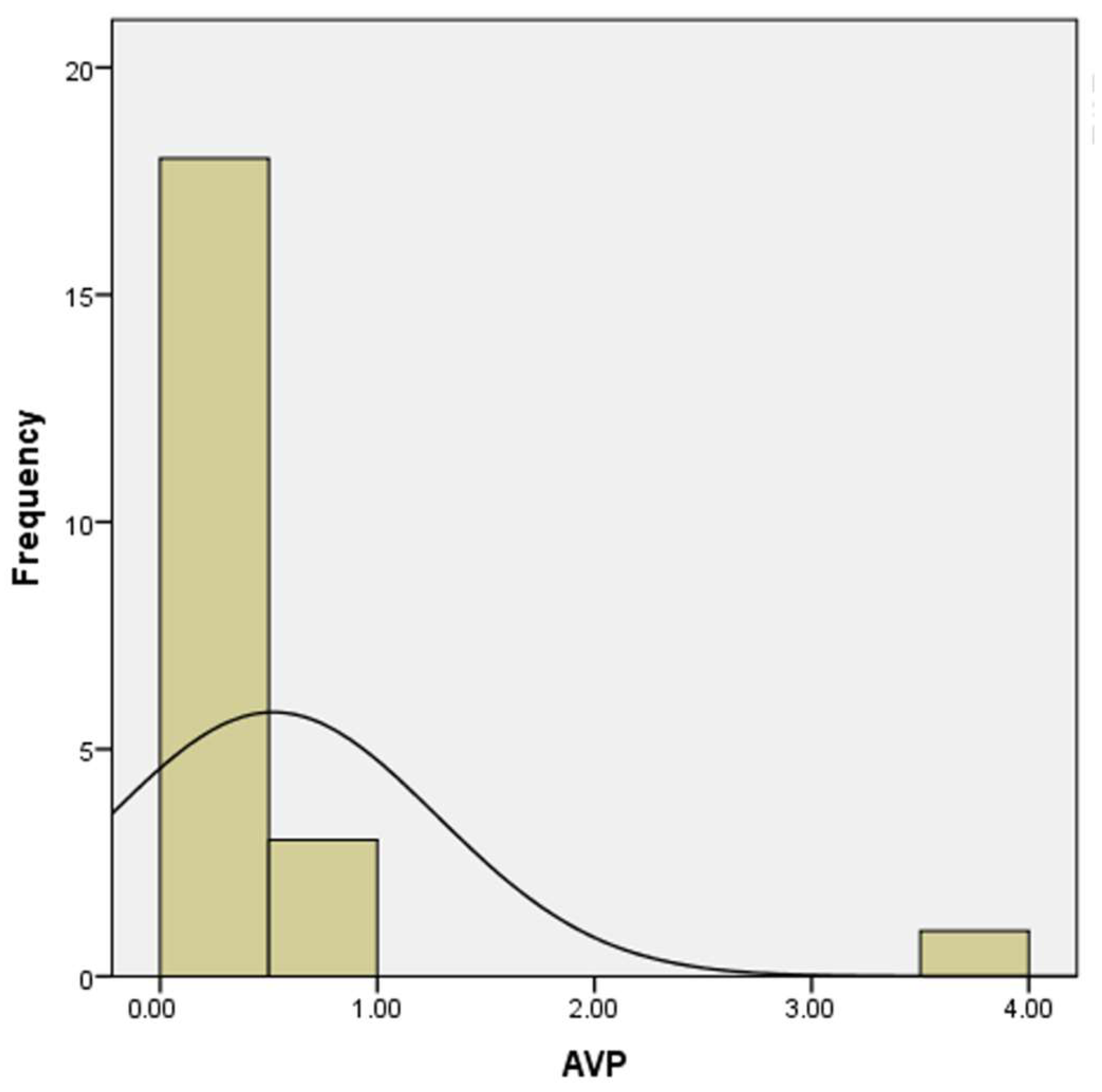
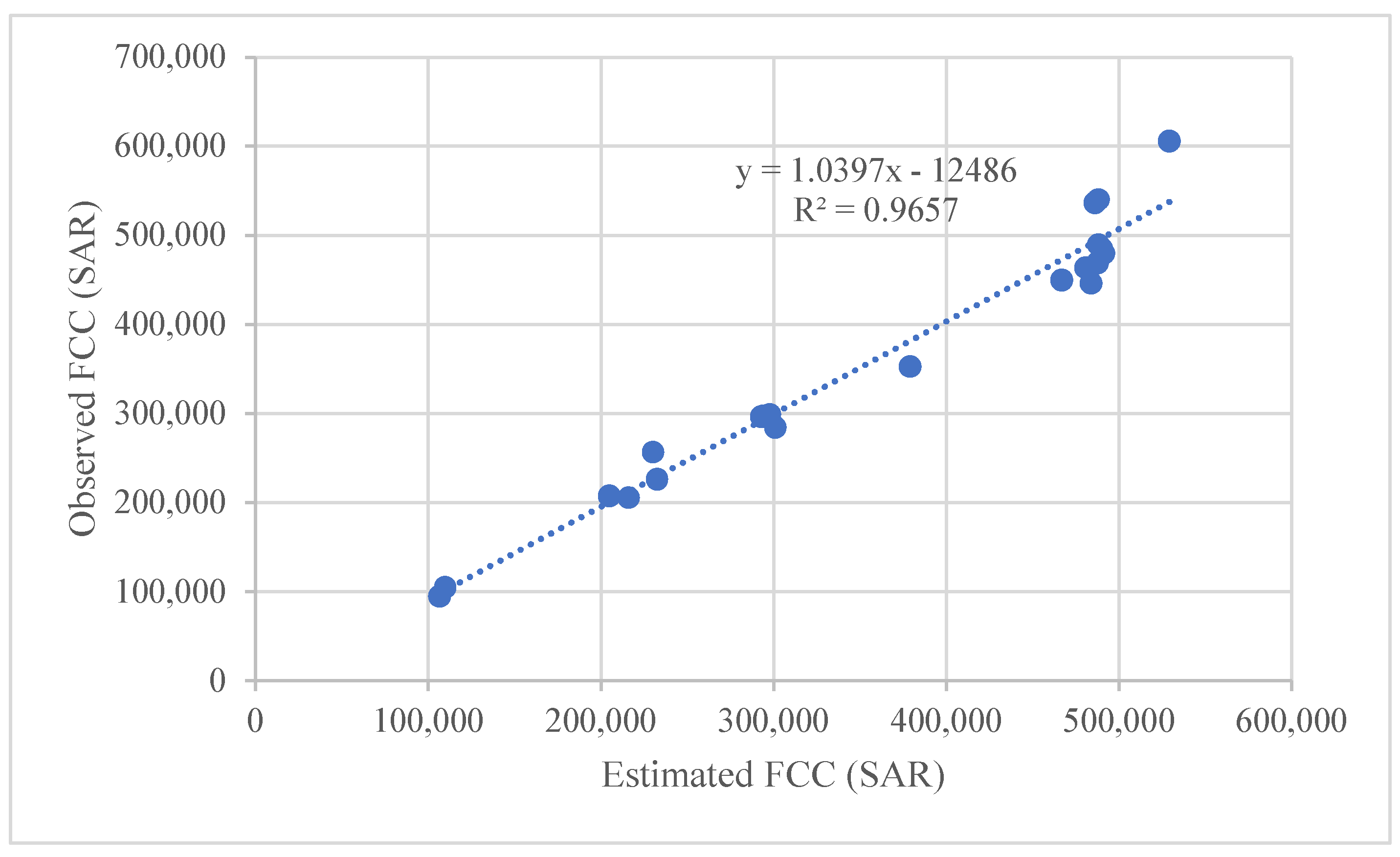
| Author/s | Stage Prediction | Client Risk | Contractor Risk | Input Data | Project Type | Purpose of Forecast | Forecast Method | Method of Collecting Data | Country |
|---|---|---|---|---|---|---|---|---|---|
| Badawy et al. [26] | ES | √ | Contract cost and Project duration and+ Contract type | Residential building | Forecast of the overall risk of projects | ANN | QUN and QUL | Egypt | |
| Ngo et al. [27] | CS | √ | - | Repetitive projects | Short-term forecasting cost | EVM | - | NS | |
| Leon et al. [28] | CS | √ | √ | CI and SCI and QI and PI and SI and TSI and CSI | Construction project | Cost performance according to 8 indices | SD | QUN and QUL | NS |
| Ye [4] | CS | - | - | Structure characteristics for area, loading, CI | Building project | Predict construction project cost (OCE) | ML and RA | QUN | NS |
| Gao and Pishdad-Bozorgi [29] | PCS | - | - | HIS and OCE and AIR and UPC | Building facility | Life cycle cost of a facility | QS and ML | QUL and QUN | NS |
| Natarajan [29] | √ | √ | Project performance data. | Construction project | Cost forecasting method of oil and gas project | QS and ML | QUL and QUN | NS | |
| Garza and Hernández [30] | AS | √ | PV | Construction project | FCC | SA | QUN | NS | |
| Lowe [5] | ES | √ | - | 286 projects’ data in terms of strategy, site, design, function, duration, mechanical installations | Construction project | Predict construction cost (OCE) | MLR and ANN | QUN | UK |
| Odeyinka et al. [31] | CS | √ | √ | Related contractor factors Related and client factors and 55 projects’ data | Construction project | Forecast risk impacts on construction cost | QS and MLR | QUL and QUN | UK |
| Xu et al. [32] | ES | √ | √ | Utility project characteristics | Transmission line | Forecast transmission line project cost (OCE) | BP-NN | QUN | China |
| Thomas and Thomas [2] | ES | √ | - | Area of project and OCE | Building project | Estimate actual cost | RA | QUN | NS |
| Ng et al. [33] | PCS | √ | - | Tender price index | Construction project | Forecast CC based on historical cost data | RA and TS | QUN | NS |
| Skitmore and Ng [7] | ES | √ | √ | CC, contract duration, project type, bidding policy, sector type | Construction project | Forecast FCC | LR | QUL and QUN | Australia |
| Kim and Reinschmidt [34] | ES | - | √ | BAG | Construction project | Forecast project cost based on developed EVM | EN and Bayesian inference | QUL and QUN | NS |
| Mir et al. [35] | ES | - | - | Asphalt and steel material prices with time | Highway and Steel frame project | Construction material | ANN and LUBE | QUL and QUN | USA |
| Aretoulis [8] | ES | √ | - | 20 highway projects properties | Highway project | FCC | ANN and WEKA | QUN | Greece |
| Moghayedi and Windapo [36] | ES | √ | √ | Size of 76 uncertain events | Highway project | Examine impact of risk on FCC and time | QS and ML | QUL | South Africa |
| Badawy [6] | ES | √ | 174 building projects Area and number of floor | Residential building | Estimate construction cost (OCE) | ANN and RA | QUL and QUN | Egypt |
| Reference | Methodology | Field | Purpose |
|---|---|---|---|
| Anysz et al. [39] | Five-type standardized method | Construction Engineering | Find a standardized method that provides a minimum error |
| Pasini [40] | Augmented training set and early stopping and correlation analysis | Health Care | Maximize data and avoid overfitting issues and determine the linear and nonlinear variables |
| Aretoulis [8] | Correlation analysis and WEKA analysis | Highway Engineering | Identify significant predictors |
| Amiri and Mirzakuchaki [42] | Use contourlet and stationary wavelet transform | Electronic Science | Increase the quality of an image |
| Zayed [41] | Eliminate the data that had a significant residual error | Construction Engineering | Increase the normality of the data |
| Vinayagam et al. [43] | Eliminate the data that had a significant residual error | Biology | Increase the normality of the data |
| CDpre-tendering | CDconstruction | ||
|---|---|---|---|
| CDpre-tendering | Pearson Correlation | 1 | −0.968 |
| Sig. (2-tailed) | 0.000 | ||
| N | 34 | 34 | |
| CDconstruction | Pearson Correlation | −0.968 | 1 |
| Sig. (2-tailed) | 0.000 | ||
| N | 34 | 34 | |
| Kolmogorov–Smirnov | Shapiro–Wilk | |||||
|---|---|---|---|---|---|---|
| Statistic | df | Sig. | Statistic | df | Sig. | |
| OCE | 0.468 | 33 | 0.000 | 0.430 | 33 | 0.000 |
| CC | 0.473 | 33 | 0.000 | 0.454 | 33 | 0.000 |
| FCC | 0.412 | 33 | 0.000 | 0.397 | 33 | 0.000 |
| Number of the Run | Relative Error (RE) | |
|---|---|---|
| Training | Testing | |
| 1 | 0.081 | 0.82 |
| 2 | 0.009 | 0.925 |
| 3 | 0.040 | 0.944 |
| NO | OCE | CC | FCC | APE (%) | ||||
|---|---|---|---|---|---|---|---|---|
| 1 | 0.14 | 0.11 | 0.11 | 41.61 | 40.91 | 41.04 | 41.20 | 4.73 |
| 2 | 0.50 | 0.48 | 0.48 | 46.22 | 46.28 | 46.43 | 46.52 | 2.39 |
| 3 | 0.49 | 0.49 | 0.54 | 46.15 | 46.35 | 46.83 | 46.48 | 9.46 |
| 4 | 0.30 | 0.30 | 0.30 | 44.38 | 44.58 | 44.73 | 44.68 | 1.16 |
| 5 | 0.12 | 0.10 | 0.10 | 41.20 | 40.60 | 40.70 | 41.09 | 11.68 |
| 6 | 0.25 | 0.21 | 0.21 | 43.78 | 43.32 | 43.43 | 43.60 | 4.98 |
| 7 | 0.24 | 0.15 | 0.21 | 43.64 | 42.28 | 43.46 | 43.41 | 1.40 |
| 8 | 0.30 | 0.30 | 0.30 | 44.41 | 44.61 | 44.76 | 44.74 | 0.50 |
| 9 | 0.35 | 0.35 | 0.35 | 44.99 | 45.19 | 45.34 | 45.60 | 7.44 |
| 10 | 0.26 | 0.23 | 0.23 | 43.92 | 43.63 | 43.77 | 43.86 | 2.58 |
| 11 | 0.50 | 0.50 | 0.48 | 46.22 | 46.40 | 46.47 | 46.51 | 1.09 |
| 12 | 0.26 | 0.26 | 0.26 | 43.92 | 44.07 | 44.22 | 43.83 | 10.39 |
| 13 | 0.70 | 0.69 | 0.61 | 47.41 | 47.57 | 47.26 | 46.78 | 12.70 |
| 14 | 0.50 | 0.49 | 0.54 | 46.19 | 46.37 | 46.86 | 46.50 | 9.64 |
| 15 | 0.49 | 0.48 | 0.45 | 46.11 | 46.30 | 46.18 | 46.47 | 8.44 |
| 16 | 0.50 | 0.49 | 0.49 | 46.19 | 46.35 | 46.51 | 46.50 | 0.25 |
| 17 | 10.00 | 11.84 | 3.84 | 56.77 | 57.62 | 53.82 | 46.94 | 85.58 |
| 18 | 0.30 | 0.30 | 0.30 | 44.39 | 44.59 | 44.73 | 44.69 | 1.04 |
| 19 | 0.30 | 0.29 | 0.29 | 44.42 | 44.44 | 44.59 | 44.78 | 5.61 |
| 20 | 0.49 | 0.47 | 0.47 | 46.15 | 46.20 | 46.35 | 46.49 | 3.95 |
| 21 | 0.48 | 0.48 | 0.46 | 46.06 | 46.27 | 46.31 | 46.44 | 3.61 |
| 22 | 0.45 | 0.45 | 0.45 | 45.86 | 46.06 | 46.21 | 46.34 | 3.75 |
| Number of the Run | Relative Error (RE) | |
|---|---|---|
| Training | Testing | |
| 1 | 0.064 | 0.047 |
| 2 | 0.053 | 0.004 |
| 3 | 0.057 | 0.112 |
Disclaimer/Publisher’s Note: The statements, opinions and data contained in all publications are solely those of the individual author(s) and contributor(s) and not of MDPI and/or the editor(s). MDPI and/or the editor(s) disclaim responsibility for any injury to people or property resulting from any ideas, methods, instructions or products referred to in the content. |
© 2023 by the authors. Licensee MDPI, Basel, Switzerland. This article is an open access article distributed under the terms and conditions of the Creative Commons Attribution (CC BY) license (https://creativecommons.org/licenses/by/4.0/).
Share and Cite
Alsugair, A.M.; Alsanabani, N.M.; Al-Gahtani, K.S. Forecasting the Final Contract Cost on the Basis of the Owner’s Cost Estimation Using an Artificial Neural Network. Buildings 2023, 13, 786. https://doi.org/10.3390/buildings13030786
Alsugair AM, Alsanabani NM, Al-Gahtani KS. Forecasting the Final Contract Cost on the Basis of the Owner’s Cost Estimation Using an Artificial Neural Network. Buildings. 2023; 13(3):786. https://doi.org/10.3390/buildings13030786
Chicago/Turabian StyleAlsugair, Abdulah M., Naif M. Alsanabani, and Khalid S. Al-Gahtani. 2023. "Forecasting the Final Contract Cost on the Basis of the Owner’s Cost Estimation Using an Artificial Neural Network" Buildings 13, no. 3: 786. https://doi.org/10.3390/buildings13030786
APA StyleAlsugair, A. M., Alsanabani, N. M., & Al-Gahtani, K. S. (2023). Forecasting the Final Contract Cost on the Basis of the Owner’s Cost Estimation Using an Artificial Neural Network. Buildings, 13(3), 786. https://doi.org/10.3390/buildings13030786












